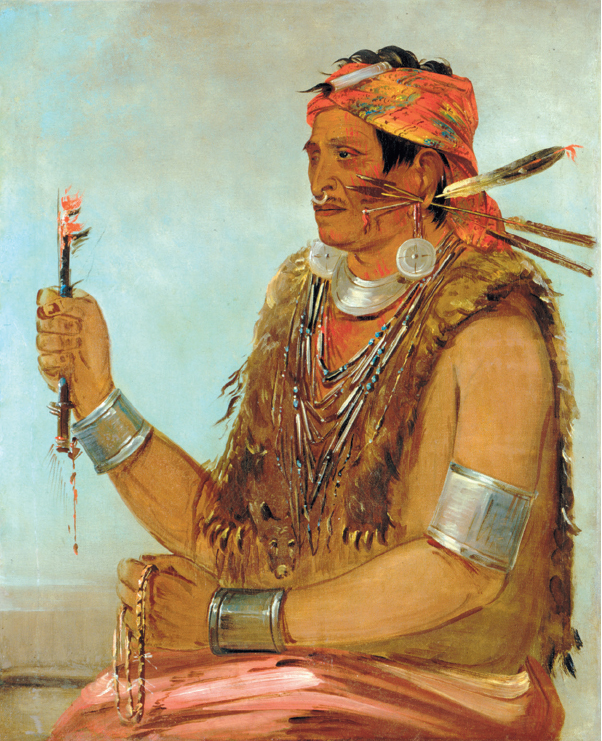America’s History: Printed Page 234
America: A Concise History: Printed Page 214
America’s History: Value Edition: Printed Page 208
Conflict in the Atlantic and the West
As Napoleon conquered European countries, he cut off their commerce with Britain and seized American merchant ships that stopped in British ports. The British ministry responded with a naval blockade and seized American vessels carrying sugar and molasses from the French West Indies. The British navy also searched American merchant ships for British deserters and used these raids to replenish its crews, a practice known as impressment. Between 1802 and 1811, British naval officers impressed nearly 8,000 sailors, including many U.S. citizens. In 1807, American anger boiled over when a British warship attacked the U.S. Navy vessel Chesapeake, killing three, wounding eighteen, and seizing four alleged deserters. “Never since the battle of Lexington have I seen this country in such a state of exasperation as at present,” Jefferson declared.
The Embargo of 1807 To protect American interests, Jefferson pursued a policy of peaceful coercion. The Embargo Act of 1807 prohibited American ships from leaving their home ports until Britain and France stopped restricting U.S. trade. A drastic maneuver, the embargo overestimated the reliance of Britain and France on American shipping and underestimated the resistance of merchants, who feared the embargo would ruin them. In fact, the embargo cut the American gross national product by 5 percent and weakened the entire economy. Exports plunged from $108 million in 1806 to $22 million in 1808, hurting farmers as well as merchants. “All was noise and bustle” in New York City before the embargo, one visitor remarked; afterward, everything was closed up as if “a malignant fever was raging in the place.”
Despite popular discontent over the embargo, voters elected Republican James Madison to the presidency in 1808. A powerful advocate for the Constitution, the architect of the Bill of Rights, and a prominent congressman and party leader, Madison had served the nation well. But John Beckley, a loyal Republican, worried that Madison would be “too timid and indecisive as a statesman,” and events proved him right. Acknowledging the embargo’s failure, Madison replaced it with new economic restrictions, which also failed to protect American commerce.

Western War Hawks Republican congressmen from the West were certain that Britain was the primary offender. They pointed to its trade with Indians in the Ohio River Valley in violation of the Treaty of Paris and Jay’s Treaty. Bolstered by British guns and supplies, the Shawnee war chief Tecumseh revived the Western Confederacy in 1809. His brother, the prophet Tenskwatawa, provided the confederacy with a powerful nativist ideology. He urged Indian peoples to shun Americans, “the children of the Evil Spirit … who have taken away your lands”; renounce alcohol; and return to traditional ways. The Shawnee leaders found their greatest support among Kickapoo, Potawatomi, Winnebago, Ottawa, and Chippewa warriors: Indians of the western Great Lakes who had so far been largely shielded from the direct effects of U.S. westward expansion. They flocked to Tenskwatawa’s holy village, Prophetstown, in the Indiana Territory.
As Tecumseh mobilized the western Indian peoples for war, William Henry Harrison, the governor of the Indiana Territory, decided on a preemptive strike. In November 1811, when Tecumseh went south to seek support from the Chickasaws, Choctaws, and Creeks, Harrison took advantage of his absence and attacked Prophetstown. The governor’s 1,000 troops and militiamen traded heavy casualties with the confederacy’s warriors at the Battle of Tippecanoe and then destroyed the holy village.
With Britain assisting Indians in the western territories and seizing American ships in the Atlantic, Henry Clay of Kentucky, the new Speaker of the House of Representatives, and John C. Calhoun, a rising young congressman from South Carolina, pushed Madison toward war. Like other Republican “war hawks” from the West and South, they wanted to seize territory in British Canada and Spanish Florida. With national elections approaching, Madison issued an ultimatum to Britain. When Britain failed to respond quickly, the president asked Congress for a declaration of war. In June 1812, a sharply divided Senate voted 19 to 13 for war, and the House of Representatives concurred, 79 to 49.
The causes of the War of 1812 have been much debated. Officially, the United States went to war because Britain had violated its commercial rights as a neutral nation. But the Federalists in Congress who represented the New England and Middle Atlantic merchants voted against the war; and in the election of 1812, those regions cast their 89 electoral votes for the Federalist presidential candidate, De Witt Clinton of New York. Madison amassed most of his 128 electoral votes in the South and West, where voters and congressmen strongly supported the war. Many historians therefore argue that the conflict was actually “a western war with eastern labels” (American Voices).